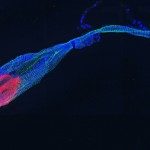Lien vers Pubmed [PMID] – 15048776
Biopolymers 2004 Apr;73(6):727-34
Optical spectroscopic techniques such as CD, Raman scattering, and fluorescence imaging allowed us to analyze the complex formation and vectorization of a single-stranded 20-mer phosphorothioate oligodeoxynucleotide with a 15-mer amphipathic peptide at molecular and cellular levels. Different solvent mixtures (methanol and water) and molecular ratios of peptide/oligodeoxynucleotide complexes were tested in order to overcome the problems related to solubility. Optimal conditions for both spectroscopic and cellular experiments were obtained with the molecular ratio peptide/oligodeoxynucleotide equal to 21:4, corresponding to a 7:5 ratio for their respective +/- charge ratio. At the molecular level, CD and Raman spectra were consistent with a alpha-helix conformation of the peptide in water or in a methanol-water mixture. The presence of methanol increased considerably the solubility of the peptide without altering its alpha-helix conformation, as evidenced by CD and Raman spectroscopies. UV absorption melting profile of the oligodeoxynucleotide gave rise to a flat melting profile, corresponding to its random structure in solution. Raman spectra of oligodeoxynucleotide/peptide complexes could only be studied in methanol/water mixture solutions. Drastic changes observed in Raman spectra have undoubtedly shown: (a) the perturbation occurred in the peptide secondary structure, and (b) possible interaction between the lysine residues of the peptide and the oligodeoxynucleotide. At the cellular level, the complex was prepared in a mixture of 10% methanol and 90% cell medium. Cellular uptake in optimal conditions for the oligodeoxynucleotide delivery with low cytotoxicity was controlled by fluorescence imaging allowing to specifically locate the compacted oligonucleotide labeled with fluorescein at its 5′-terminus with the peptide into human glioma cells after 1 h of incubation at 37 degrees C.

